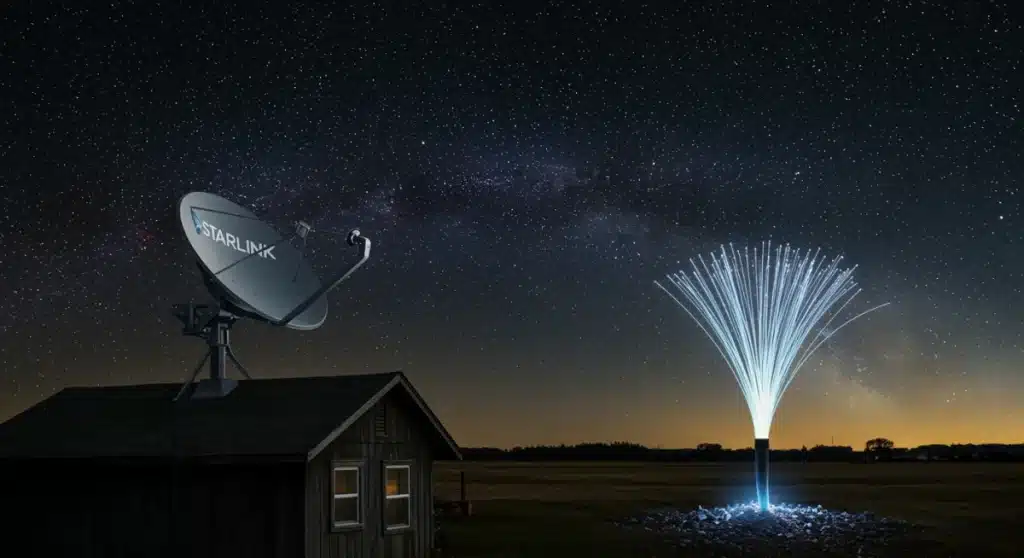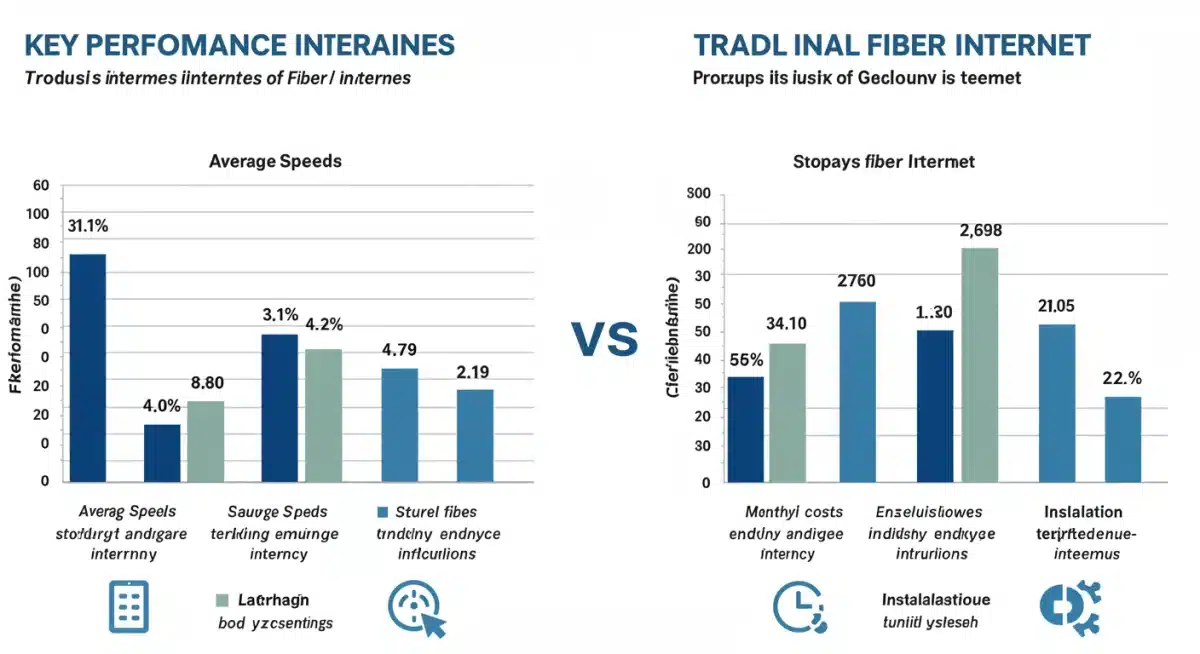Starlink vs. Traditional Fiber: 2025 Rural US Connectivity

The ongoing competition between Starlink and traditional fiber internet is critically impacting rural US global connectivity as 2025 approaches, defining access for underserved communities with evolving technological capabilities and infrastructure.
The battle for rural internet access in the United States is rapidly evolving, with Starlink vs. Traditional Fiber: A 2025 Comparison for Rural US Global Connectivity (COMPARISON/ANALYSIS) at the forefront. As we approach 2025, how will these two titans of connectivity stack up, especially for those in underserved areas? This in-depth look explores the current landscape and future prospects, helping to clarify which technology is poised to deliver reliable, high-speed internet to the farthest reaches of the nation.
The Current Landscape: Starlink’s Satellite Surge
Starlink, SpaceX’s satellite internet constellation, has rapidly emerged as a formidable contender in the rural broadband market. Its promise of high-speed, low-latency internet from space has been a game-changer for many who previously had limited or no options. As of late 2024, Starlink continues to expand its constellation and ground infrastructure, improving service reliability and capacity across vast geographical areas, particularly in the United States.
The system leverages a growing network of low Earth orbit (LEO) satellites, significantly reducing the latency issues historically associated with geostationary satellite internet. This technological leap has made activities like online gaming, video conferencing, and streaming, once impossible for many rural residents, a daily reality. The ease of self-installation and the relatively quick deployment time are major attractions for individuals and communities desperate for immediate connectivity solutions.
Starlink’s Technological Edge
- Low Latency: LEO satellites orbit much closer to Earth, drastically cutting signal travel time.
- Broad Coverage: Capable of reaching almost any location globally, regardless of terrain.
- Rapid Deployment: Users can typically set up their equipment within minutes of receiving it.
However, Starlink’s service is not without its considerations. While speeds are generally impressive for satellite internet, they can vary based on network congestion, weather conditions, and the number of active users in a given cell. The initial hardware cost can also be a barrier for some, despite ongoing efforts by SpaceX to reduce prices and offer financing options. Maintenance of the ground stations and the continuous launch of new satellites are critical to sustaining and improving the service quality as demand grows.
Traditional Fiber Optic: The Gold Standard’s Expansion
Traditional fiber optic internet remains the undisputed gold standard for speed and reliability, delivering symmetrical upload and download speeds that are virtually unmatched. For years, its deployment has been concentrated in urban and suburban areas due to the high cost and logistical complexities of laying physical cables. However, significant governmental initiatives and private investments are now pushing fiber deeper into rural America, aiming to bridge the digital divide.
Fiber optic technology transmits data using light signals through thin strands of glass or plastic, offering immense bandwidth and extremely low latency. This makes it ideal for data-intensive applications, large households with multiple users, and businesses that require robust and consistent internet performance. The long-term stability and resilience of fiber infrastructure are also key advantages, often requiring less maintenance once installed compared to other technologies.


Fiber’s Unrivaled Performance
- Superior Speed: Offers gigabit and multi-gigabit speeds for both uploads and downloads.
- Low Latency: Minimal signal delay, crucial for real-time applications.
- High Reliability: Less susceptible to interference from weather or network congestion.
The primary hurdle for fiber remains its deployment cost and time. Trenching and laying miles of cable across varied terrain is an expensive and time-consuming endeavor. While government subsidies, such as those from the Broadband Equity, Access, and Deployment (BEAD) program, are accelerating this process, many rural areas are still years away from having fiber access. The commitment from local governments and utility companies is also a critical factor in how quickly these projects can move forward.
Cost Comparison: Initial Outlay vs. Long-Term Value
When evaluating Starlink vs. Traditional Fiber: A 2025 Comparison for Rural US Global Connectivity (COMPARISON/ANALYSIS), cost is a pivotal factor for consumers. Starlink typically involves a significant upfront hardware cost for the dish and router, followed by a monthly subscription fee. While these costs have fluctuated, they represent a considerable initial investment for many rural households. However, the installation process is generally straightforward and can often be done by the user, saving on professional installation fees.
Fiber optic internet, on the other hand, often has a lower or even no upfront hardware cost for the consumer, as the infrastructure is typically owned and maintained by the internet service provider (ISP). However, professional installation is almost always required, which can sometimes incur a fee, though many providers waive this to attract new customers. The monthly subscription fees for fiber can be comparable to or slightly higher than Starlink, depending on the speed tier and provider.
Financial Considerations
- Starlink Upfront: Higher initial hardware cost, user-friendly self-installation.
- Fiber Upfront: Lower or no hardware cost, professional installation (potentially with a fee).
- Monthly Fees: Both have competitive monthly rates, varying by speed and provider.
The long-term value proposition also differs. Fiber infrastructure, once installed, has a very long lifespan and can be upgraded to higher speeds with relatively minor equipment changes at the endpoints. Starlink’s long-term costs include the continuous launch and maintenance of its satellite constellation, which are absorbed into the subscription fees. For consumers, the decision often comes down to immediate access versus future-proof infrastructure.
Accessibility and Availability in Rural Areas
The core of the Starlink vs. Traditional Fiber: A 2025 Comparison for Rural US Global Connectivity (COMPARISON/ANALYSIS) lies in accessibility for rural populations. Starlink’s primary advantage is its ability to provide service to remote locations that are uneconomical or geographically challenging for fiber deployment. If you have a clear view of the sky, Starlink can likely connect you. This has brought internet access to countless homes and businesses that were previously considered unserved.
Fiber’s expansion into rural areas is a more methodical and often politically driven process. It requires significant planning, investment, and often relies on government subsidies to make it financially viable for ISPs. While fiber is undoubtedly the superior technology where available, its availability in deeply rural areas is still limited and will remain so for the foreseeable future, despite accelerated deployment efforts. Communities often have to wait for years, or even decades, for fiber to reach their doorsteps.
Consideration must be given to the density of housing and local terrain. Fiber is most cost-effective in areas with a certain population density, even if rural. Scattered homes across vast distances make fiber deployment prohibitively expensive. Starlink, conversely, thrives in these sparse environments, offering a viable solution where physical infrastructure is impractical. This dynamic is crucial for understanding the evolving rural connectivity landscape.
Speed, Latency, and Reliability: A Technical Deep Dive
In a technical deep dive for Starlink vs. Traditional Fiber: A 2025 Comparison for Rural US Global Connectivity (COMPARISON/ANALYSIS), speed, latency, and reliability are paramount. Fiber optic internet consistently delivers the highest speeds, often reaching symmetrical gigabit or even multi-gigabit levels. Its latency is exceptionally low, typically in the single-digit milliseconds, making it ideal for real-time applications like cloud computing, competitive online gaming, and high-quality video conferencing.
Starlink, while offering impressive speeds for satellite internet, generally provides download speeds ranging from 50 Mbps to 250 Mbps, with upload speeds considerably lower. Latency typically falls between 20 ms and 60 ms, a vast improvement over traditional geostationary satellites but still higher than fiber. These speeds are more than adequate for most household needs, but may not meet the demands of very heavy users or businesses that require robust and consistent internet performance. US Companies are increasingly looking for reliable data flows.
Service Performance Metrics
Reliability is another key differentiator. Fiber optic cables are buried underground or strung on poles, making them generally resilient to weather conditions, though physical damage from construction or natural disasters can occur. Starlink, being satellite-based, can experience some degradation in service during severe weather events like heavy rain or snow, which can interfere with the signal. However, the system is designed to be robust, and minor weather impacts are usually brief.
Network congestion also plays a role. Fiber lines have massive capacity, meaning congestion is rarely an issue for residential users. Starlink’s capacity is shared among users in a service cell, so performance can fluctuate during peak usage times, especially as its user base grows. SpaceX is continuously launching more satellites to increase network capacity and improve performance, but it’s an ongoing balancing act.
Government Initiatives and Future Outlook for 2025
The future of rural internet access, particularly in the context of Starlink vs. Traditional Fiber: A 2025 Comparison for Rural US Global Connectivity (COMPARISON/ANALYSIS), is heavily influenced by government initiatives. The US federal government, through programs like the Broadband Equity, Access, and Deployment (BEAD) program and the ReConnect Program, has allocated billions of dollars to expand broadband infrastructure, with a significant focus on fiber optic deployment in underserved areas.
These programs prioritize wired solutions where feasible, recognizing fiber’s long-term benefits and superior performance. However, they also acknowledge the role of satellite and fixed wireless technologies as complementary solutions for the hardest-to-reach locations. This layered approach suggests that both Starlink and fiber will continue to play crucial roles in achieving universal broadband access by 2025 and beyond.
Key Future Trends
- Increased Fiber Investment: Government subsidies will continue to drive fiber expansion into more rural areas.
- Starlink Evolution: SpaceX will launch more advanced satellites, improving speed and capacity.
- Hybrid Solutions: A combination of fiber backbones and last-mile satellite/fixed wireless will become more common.
Looking ahead to 2025, we anticipate a landscape where fiber continues its steady, albeit slow, march into rural communities, becoming the preferred option where economically viable. Starlink, meanwhile, will likely solidify its position as the go-to solution for truly remote areas, continuing to innovate and improve its service. The competition will ultimately benefit consumers, driving down costs and improving service quality across the board. Regulatory frameworks will also evolve to ensure fair access and competition.
| Key Point | Brief Description |
|---|---|
| Accessibility | Starlink excels in remote areas; Fiber requires physical infrastructure. |
| Performance | Fiber offers superior speed/latency; Starlink provides good speeds for satellite. |
| Cost Structure | Starlink has high upfront hardware; Fiber often has lower initial consumer cost. |
| Future Outlook | Both technologies will expand, with fiber in denser rural areas and Starlink in remote. |
Frequently Asked Questions About Rural Connectivity
Starlink’s primary advantage for rural users in 2025 is its unparalleled accessibility. It can deliver high-speed internet to nearly any location with a clear view of the sky, bypassing the need for extensive ground infrastructure that often makes traditional fiber deployment impractical or too costly for remote areas.
Fiber optic internet offers significantly lower latency, typically in the single-digit milliseconds, due to data transmission via light through cables. Starlink, while vastly improved over older satellite systems, has latency usually between 20-60 milliseconds, which is still very good for most uses but higher than fiber.
Government subsidies, like the BEAD program, primarily prioritize fiber optic deployment where feasible due to its superior long-term performance and reliability. However, they also acknowledge and fund satellite and fixed wireless solutions, including Starlink, for the hardest-to-reach and most geographically challenging rural areas.
Starlink typically involves a higher upfront cost for hardware, plus a monthly subscription. Fiber often has lower or no upfront hardware cost, with professional installation fees that are sometimes waived, followed by competitive monthly subscription fees. Long-term costs vary based on plans and maintenance.
By 2025, Starlink’s system will be more robust, but severe weather like heavy rain or snow can still cause temporary signal degradation. However, these impacts are generally brief and the system is designed for high resilience. Fiber, being a wired connection, is largely unaffected by atmospheric weather conditions.
What Happens Next
As we move further into 2025, the trajectory for rural US global connectivity points towards an increasingly diversified landscape. The ongoing push for fiber expansion, fueled by significant federal funding, will continue to connect more previously underserved communities. Simultaneously, Starlink is set to further refine its technology, launching more advanced satellites and improving its ground infrastructure to enhance speed, capacity, and reliability. This evolving competition and collaboration between terrestrial and satellite solutions will ultimately dictate the pace at which the digital divide in rural America is finally bridged, ensuring that reliable internet access becomes a reality for all.





